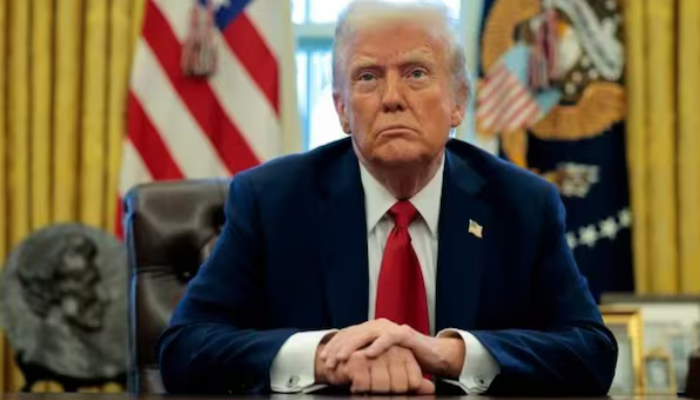
In a move that could send shockwaves through global oil markets, US President Donald Trump has announced a 25% tariff on all countries purchasing oil and gas from Venezuela. The decision is expected to impact key buyers, including India, China, Spain, and even some US-based refiners, leading to increased energy costs and possible shifts in global trade dynamics.
The announcement, made via Trump’s Truth Social account, underscored his administration’s hardline stance against Venezuelan President Nicolás Maduro, whom the US has long accused of human rights violations and economic mismanagement.
“Venezuela has been very hostile to the United States and the freedoms we espouse. Therefore, any country that purchases oil and/or gas from Venezuela will be forced to pay a tariff of 25% on any trade they do with our country,“ Trump wrote.
The tariff will take effect on April 2, according to an executive order signed on Monday. The measure will remain in place for one year after a country’s last recorded Venezuelan oil purchase or until the US government determines otherwise.
India’s Heavy Dependence on Venezuelan Crude
India has been a major consumer of Venezuelan oil, with shipments increasing steadily over the past few years. In December 2023 and January 2024, India emerged as Venezuela’s top buyer, importing:
- 191,600 barrels per day (bpd) in December
- Over 254,000 bpd in January, accounting for nearly half of Venezuela’s total crude exports (557,000 bpd)
In 2024 alone, India imported approximately 22 million barrels of Venezuelan crude, making up 1.5% of its total crude oil purchases. These numbers highlight India’s reliance on Venezuelan oil as part of its broader energy security strategy.
With Trump’s tariff set to take effect, India will face higher costs for Venezuelan crude. Indian refiners, including Reliance Industries and Nayara Energy, might need to reconsider their sourcing strategies, potentially shifting towards suppliers from the Middle East, Russia, or the United States.
However, the move could also push India to negotiate discounted oil prices with Venezuela, or even explore alternative payment methods—similar to how it has handled sanctions on Russian oil by purchasing crude at reduced rates through non-dollar transactions.
Global Oil Market Reactions
Trump’s announcement immediately sent oil prices higher, as uncertainty loomed over global supply chains. On Monday, following the news:
- Brent crude prices surged 1.2%, rising to $73 per barrel
- West Texas Intermediate (WTI) climbed 1.2% to $69.11 per barrel
Despite the initial price jump, market analysts believe that global supply concerns may be tempered by a key US decision: The Biden-era license granted to Chevron for oil operations in Venezuela has been extended until May 27, allowing the American energy giant more time to wind down its Venezuelan operations.
While this softens the immediate impact of Trump’s tariff, Asian and European buyers of Venezuelan oil remain in a precarious position. Experts suggest that some countries might seek alternative supply routes, or work around the tariff through currency swaps or barter agreements, strategies already used by nations under previous US sanctions.
Trump’s Tariff Plans: Economic Strategy or Political Pressure?
Since returning to the White House in January, Trump has aggressively pursued a tariff-driven economic policy, targeting both US allies and adversaries alike. The Venezuelan oil tariff is part of a broader economic agenda, with Trump labeling April 2 as “Liberation Day” for the US economy.
His administration claims these tariffs will help counter unfair trade practices and hostile regimes, but critics argue that they could:
- Increase inflationary pressures in oil-importing nations
- Strain diplomatic relations with key trade partners, including India and China
- Disrupt global energy markets, leading to unpredictable price swings
Furthermore, the logistics of enforcing such a sweeping tariff remain unclear. Questions linger about how US customs will monitor oil flows, particularly if buyers rebrand Venezuelan crude as a different origin—a practice seen in the past with sanctioned Iranian and Russian oil.
India’s Next Moves: A Diplomatic and Economic Balancing Act
India now faces a crucial decision:
- Absorb higher costs by paying the tariff, which could impact refining margins and consumer fuel prices
- Diversify its oil imports by increasing purchases from Russia, the Middle East, or US crude suppliers
- Seek diplomatic solutions, possibly negotiating for tariff exemptions or special trade arrangements
Given India’s strategic autonomy in foreign policy, it is likely to carefully weigh its options. New Delhi has previously balanced economic interests with geopolitical pressures, as seen in its handling of Russian oil purchases amid Western sanctions.
As the April 2 deadline approaches, Indian policymakers and energy companies will be closely monitoring market trends, while engaging in backchannel diplomacy to mitigate potential disruptions.
Conclusion: A Turbulent Road Ahead for Global Oil Trade
Trump’s 25% tariff on Venezuelan oil buyers is set to reshape global trade dynamics, with India and China among the most affected nations. While the immediate impact is rising oil prices and trade uncertainty, the long-term implications depend on how global markets adjust and whether countries find ways to circumvent or absorb the tariff costs.
For now, energy markets remain on edge, awaiting official responses from India, China, and other major importers. The coming weeks will be crucial in determining whether this move triggers wider economic repercussions or becomes another chapter in the ongoing global trade wars.

